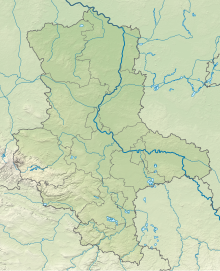Kramer shark
Coordinates: 51 ° 44 ′ 33 " N , 10 ° 38 ′ 30" E
The Kramershai in the Harz district in Saxony-Anhalt is a 1.8 km² or 1.75 km² nature reserve in the Harz in the urban area of Upper Harz am Brocken that has existed since the beginning of 2000 .
The nature reserve with the CDDA no. 318685 and the registration number NSG 0159 was identified in 1999 (date of the regulation: December 2, 1999). The responsible lower nature conservation authority is the Harz district. The aim of the protection is to “protect and promote the highest beech deposits in the Harz Mountains and the small-scale moor and spring areas”.
Geographical location
The Kramershai is located in the Harz / Saxony-Anhalt Nature Park 3 km west of Elend (to Oberharz am Brocken ), 2.7 km south-southwest of Schierke (to Wernigerode ), both of which are in the Harz district (Saxony-Anhalt), and 2, 8 km (as the crow flies ) northeast of Braunlage , which belongs to the Lower Saxony district of Goslar . It is located in a forest area on the southern slope of the Kleiner Winterberg ( 837 m above sea level ). The nature reserve is located in the conservation area "resin and flood plains". Its southern border is Bundesstraße 27 , in the west it meets the Bremke (with Bremkefall there), a northern tributary of the Warmen Bode , a few meters beyond the former column path of the former inner-German border ; Beyond the Bremke, the Große Wurmbergstraße runs as the Lower Saxony district road 41 , which leads to the nearby Wurmberg ( 971.2 m ). In several places in the east, south and west the Kramershai borders on the nature reserve " Harzer Bachtäler ". In its northern part, the small Fahnenbach rises as the left source brook of the Spielbach flowing east to the Warmen Bode .
flora
Small areas of bog and spring areas occur in the Kramershai. In large parts of the nature reserve there are spruce forests in which valuable red beech and spruce forests are embedded. This is the highest occurrence of red beech in the Saxony-Anhalt part of the Harz Mountains. The herb layer in the spruce forests is mainly made up of snakes and bilberries . In the red beech and spruce forests, besides snakeskin and bilberry, etc. a. also woolly riding grass and oak fern .
Along near-natural streams that criss- cross the nature reserve, alder forests grow in sections. Spring meadows with peat moss and bitter foam herb can be found especially in the northeast of the nature reserve . On deforested areas, herbaceous corridors with spotted and broadleaf orchid have developed in places . Small areas also come mesophilic grasslands and Nardus grasslands before. Here are u. a. Bergwohlverleih , soaring yellow sedge , common flat bear moss , round-leaved sundew and masterwort can be found.
In the long term, the spruce forests are to be converted into beech-spruce forests and beech forests.
fauna
The waste wood stocks in Kramershai are important habitats for various species of birds , including buzzards , boreal owl , black woodpecker and nutcracker . The coniferous forest areas are the habitat for mistletoe , winter and summer golden fowl , coal and crested tit and bullfinches . The nature reserve is also the habitat of the wildcat .
Funga
Notable fungal species are Wine Red gray stalk Täubling ( Russula vinosa ) Rußgrauer Täubling ( Russula consobrina ), gray Ender SpeI Täubling ( ussula griseascens ), apple Täubling ( Russula paludosa ), Russula Decolorans ( Russula decolorans ) lactarius repraesentaneus ( Lactarius repraesentaneus ), peat moss milkling ( Lactarius sphagneti ), felty milkling, Bruchreizker, Maggi mushroom ( Lactarius helvus ), pitch black milkling ( Lactarius picinus ) and Nordic milkling ( Lactarius trivialis ). A specialty is the Taiga-Täubling ( Russula taigarum ), which has only been detected a few times in Germany.
Web links
Individual evidence
- ↑ a b c Map services of the Federal Agency for Nature Conservation ( information )
- ↑ a b c d Kramershai , State Administration Office Saxony-Anhalt
- ↑ Hartmut Schubert: The mushrooms of the NSG Kramershai and the neighboring areas. Part 1: Russula taigarum and co . Der Tintling 94, edition 3/2015, pp. 53–63


